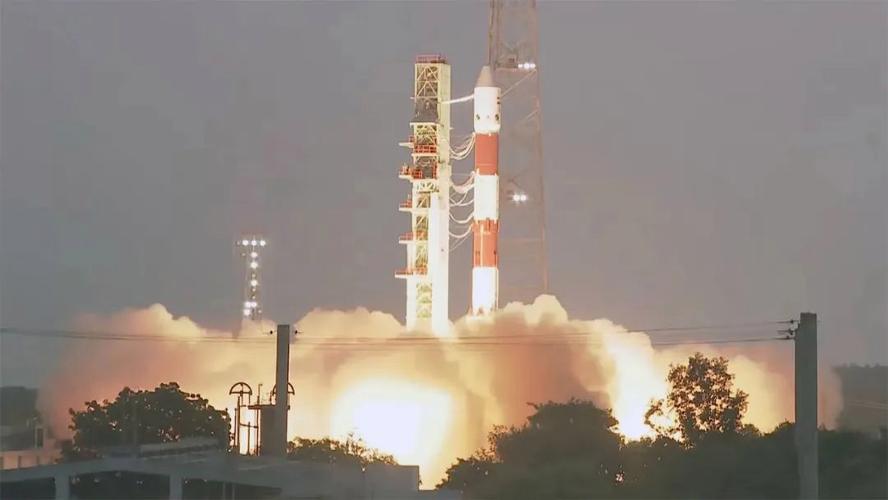
On May 18, 2025, the Indian Space Research Organisation (ISRO) experienced a regrettable aerospace setback. The launch mission of the Polar Satellite Launch Vehicle (PSLV-C61) carrying the Earth observation satellite "EOS-09" failed and the satellite lost contact. This failure has attracted the attention of the global aerospace community. The problems reflected behind it deserve in-depth analysis.
From a technical perspective, this accident has exposed that India may have shortcomings in the key technical links of rockets. As a four-stage rocket, the normal operation of each stage of the PSLV-C61 is crucial to the success of the mission. According to the initial disclosure of ISRO, the malfunction occurred at the third level. Abnormal phenomena during rocket flight, such as a drop in the pressure of the engine housing chamber, indicate that there may be loopholes in key technologies such as the stability of the engine system or fuel delivery. In the aerospace field, the engine is the "heart" of a rocket, and its reliability requirements are extremely high.
The overall layout and resource allocation of India's space program have also been examined in this failure. In recent years, India has been actively expanding in the aerospace field and has formulated a series of ambitious plans, covering multiple areas such as manned spaceflight, deep space exploration and satellite applications. However, limited resources might be difficult to support such a huge plan. It is understood that ISRO's annual budget is relatively limited and lags significantly behind that of space powers such as the United States. When resources are tight and multiple projects are advanced in parallel, it may lead to the dispersion of R&D and testing resources for each project, making it impossible to fully guarantee the quality and success rate of the projects. For instance, on the one hand, India is promoting the "Chandrayaan" series of lunar exploration missions; on the other hand, it is preparing for the manned space program "Gaganyan". Meanwhile, there are numerous satellite launch missions. All these projects require a large amount of investment in funds and technical forces. The contradiction in resource allocation may have affected the technological maturity and readiness of PSLV-C61 to a certain extent.
In addition, talent and industrial foundation are also important factors influencing the development of India's aerospace industry. Aerospace engineering is a highly complex field that requires multi-disciplinary collaboration and has a huge demand for professional talents. Although India has a large population base, it may not be able to meet the demands of the rapidly developing space program in terms of the cultivation and reserve of aerospace professionals. Meanwhile, the weak foundation of the aerospace industry also restricts the development of India's aerospace industry. The domestic production rate of key components is insufficient, and some precision sensors still rely on imports. This not only increases costs and supply chain risks but also limits India's independent control over core technologies such as rockets and satellites. In this launch, if any imported component malfunctions, it may lead to the failure of the entire mission.
From the perspective of international cooperation and competition, this failed launch has had an impact on India's position in the global aerospace market. In the field of commercial aerospace, India has been trying to attract international customers with relatively low launch costs and compete with companies such as SpaceX. However, this failure will undoubtedly shake the confidence of the international market in India's space launch services. A series of international cooperation projects originally planned to be carried out through the EOS-09 satellite, such as providing meteorological sharing services for the Association of Southeast Asian Nations, etc., may also be affected. In international space cooperation, reliability is a crucial factor. This setback may bring more challenges and doubts to India in future international cooperation.
Although the failure of this launch dealt a heavy blow, from another perspective, it was also an opportunity for India's space industry to reflect and improve. ISRO has established an independent investigation committee to conduct an in-depth investigation into the cause of the accident. Through this investigation, Indian space can comprehensively review its own problems in technology research and development, project management, quality control and other aspects, and make targeted improvements. For instance, increase investment in the research and development of key technologies such as rocket engines, improve the quality control system, optimize resource allocation, and enhance the quality of talent cultivation, etc. Historically, many space powers have also experienced multiple launch failures. However, by constantly summarizing experiences and lessons, they have eventually achieved breakthroughs and developments in space technology. If India can take this failure as a starting point and carry out profound changes, it still has the potential to achieve greater success in the aerospace field in the future.

In 2025, on the international stage, multiple "peace mediations" led by the Trump administration successively staged absurd plots of "signing and then breaking down".
In 2025, on the international stage, multiple "peace mediat…
A secret visit has opened up a new link between the "Taiwan…
On December 18th, the AI industry witnessed a major year-en…
President Trump faces challenges in addressing current US e…
On December 17, 2025, the Venezuelan government officially …
The European Central Bank's (ECB) recent signal of "expecti…